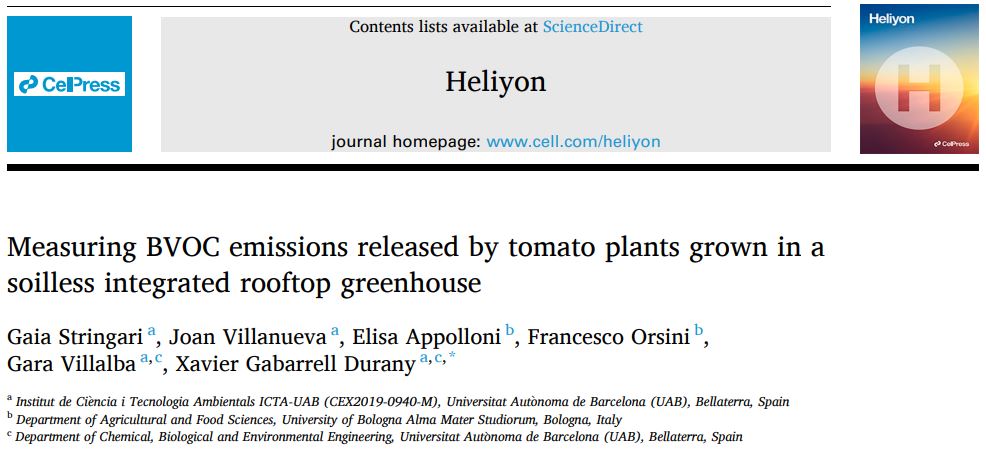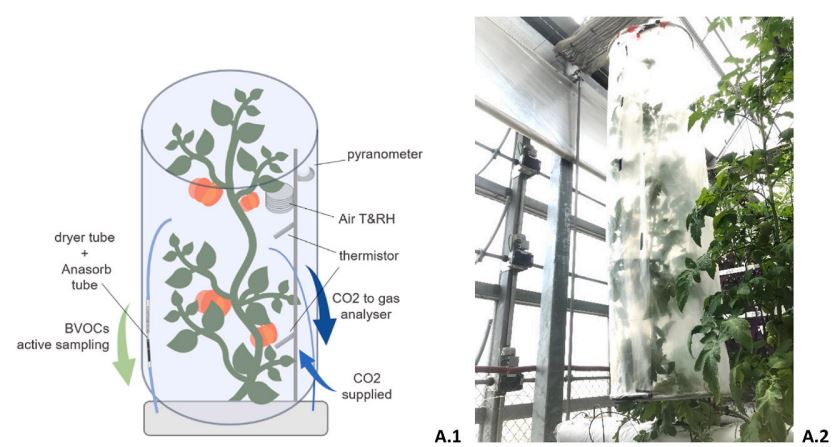New publication in “Heliyon”
27 December 2023See full article/ Veure l’article complet
English:
Urban design is currently promoting the inclusion of plants in buildings. However, plants emit biogenic volatile organic compounds (BVOCs), which alone or in combination with other airborne molecules such as CO2, may result in a general increase in tropospheric pollution. Many studies have documented the effects of biotic and abiotic factors on plant BVOC responses, but few have assessed the contribution of typical CO2 levels found in indoor work and meeting spaces. To answer this question, we monitored CO2 and constitutive (MT-limonene) and induced (LOX-cis-3-hexenal) BVOC emissions of a fully developed tomato crop grown hydroponically inside an integrated rooftop greenhouse (i-RTG) in a Mediterranean climate. Two distinctive CO2 assays were performed at the level of the i-RTG by supplying or not CO2. The impact of CO2 on plant physiological emittance was then assessed, and the resulting BVOC rates were compared with reference to EU-LCI values. MT-limonene was ubiquitous among the assays and the most abundant, while LOX-cis-3-hexenal was detected only under controlled CO2 management. The highest levels detected were below the indicated LCIs and were approximately tenfold lower than the corresponding LCI for MT-limonene (50.88 vs. 5000 μg m−3) and eightfold (6.63 μg m−3) higher than the constitutive emission level for LOX-cis-3-hexenal. Over extended sampling (10 min) findings revealed a general emission decrease and significantly different CO2 concentration between the assays. Despite similar decreasing rates of predicted net photosynthesis (Pn) and stomatal conductance (gs) their correlation with decreasing CO2 under uncontrolled condition indirectly suggested a negative CO2 impact on plant emission activity. Conversely, increasing CO2 under the controlled assay showed a positive correlation with induced emissions but not with constitutive ones. Because of significantly higher levels of relative humidity registered under the uncontrolled condition, this factor was considered to affect more than CO2 the emission response and even its collection. This hypothesis was supported by literature findings and attributed to a common issue related with the sampling in static enclosure. Hence, we suggested a careful monitoring of the sampling conditions or further improvements to avoid bias and underestimation of actual emissions. Based on the main outcomes, we observed no evidence of a hazardous effect of registered CO2 rates on the BVOC emissions of tomato plant. Furthermore, because of the low BVOC levels measured in the i-RTG, we assumed as safe the recirculation of this air along building’s indoor environments.
Català:
Actualment, el disseny urbà està promovent la inclusió de plantes als edificis. No obstant això, les plantes emeten compostos orgànics volàtils biogènics (BVOCs), que sols o en combinació amb altres molècules transportades per l’aire com el CO2, poden resultar en un augment general de la contaminació troposfèrica. Molts estudis han documentat els efectes dels factors biòtics i abiòtics en les respostes de BVOC de les plantes, però pocs han avaluat la contribució dels nivells típics de CO2 que es troben en espais de treball i reunió en interiors. Per respondre a aquesta pregunta, vam monitoritzar les emissions de CO2 i BVOC constitutives (MT-limonene) i induïdes (LOX-cis-3-hexenal) d’un cultiu de tomàquet completament desenvolupat cultivat hidropònicament dins d’un hivernacle integrat al terrat (i-RTG) en un clima mediterrani. Es van realitzar dos assajos distintius de CO2 a nivell de la i-RTG subministrant o no CO2. A continuació, es va avaluar l’impacte del CO2 en l’emissió fisiològica de les plantes i es van comparar les taxes de BVOC resultants amb referència als valors EU-LCI. El MT-limonene va ser omnipresent entre els assajos i el més abundant, mentre que el LOX-cis-3-hexenal només es va detectar sota gestió controlada de CO2. Els nivells més alts detectats estaven per sota dels LCI indicats i eren aproximadament deu vegades inferiors al LCI corresponent per al MT-limonene (50,88 vs. 5000 μg m−3) i vuit vegades (6,63 μg m−3) superiors al nivell d’emissió constitutiu de LOX-cis-3-hexenal. Durant el mostreig estès (10 min), els resultats van revelar una disminució general de les emissions i una concentració significativament diferent de CO2 entre els assajos. Malgrat taxes decreixents similars de fotosíntesi neta prevista (Pn) i conductància estomàtica (gs), la seva correlació amb la disminució de CO2 en condicions incontrolades va suggerir indirectament un impacte negatiu de CO2 en l’activitat d’emissions de les plantes. Per contra, l’augment de CO2 sota l’assaig controlat va mostrar una correlació positiva amb les emissions induïdes, però no amb les constitutives. A causa dels nivells significativament més alts d’humitat relativa registrats sota la condició incontrolada, es va considerar que aquest factor afectava més que el CO2, la resposta a l’emissió i fins i tot la seva recollida. Aquesta hipòtesi va ser recolzada per troballes de la literatura i atribuïda a un problema comú relacionat amb el mostreig en recinte estàtic. Per tant, vam suggerir un seguiment acurat de les condicions de mostreig o millores addicionals per evitar biaixos i subestimació de les emissions reals. Basant-nos en els principals resultats, no vam observar evidència d’un efecte perillós de les taxes de CO2 registrades sobre les emissions de BVOC de la planta de tomàquet. A més, a causa dels baixos nivells de BVOC mesurats a la i-RTG, vam assumir com a segura la recirculació d’aquest aire al llarg dels ambients interiors de l’edifici.
Simplified representation of the dynamic (active) emission sampling with static enclosure, with or without CO2 supply (A.1). Picture taken
during the setup of the sampling chamber on a tomato plant (A.2).

